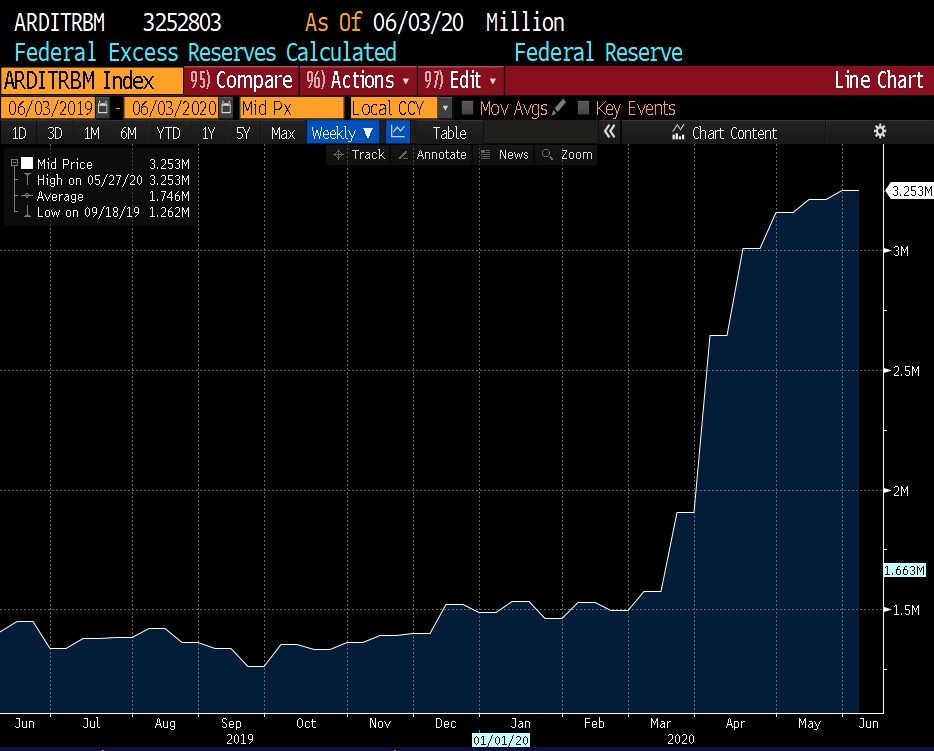In its most basic form, a bank takes in money from savers (depositors), agrees to pay them a certain interest rate and then uses those funds to lend to borrowers at a higher interest rate, thus earning the difference as their income. But they are not allowed to lend out 100% of those deposits because the Federal Reserve wants them to hold a small percentage to cover any defaults arising from those loans they made. This small percentage held back at the Fed is called required reserves. Sometimes, banks do not lend out all that they can. This could be because they are not finding enough opportunities to lend, either due to a poor economic outlook, little demand from borrowers, or weak financial conditions of the borrower.
In that case the bank can take those excess deposits and invest in marketable securities or just hold it at the Federal Reserve earning a nominal interest rate. These reserves are called excess reserves.
Since the end of February, deposits at US banks have ballooned, and, as a result, rates that banks pay for those deposits have moved to lows not seen since the great recession.
From February 26th until June 3rd, excess deposits of US banks held at the Federal Reserve have increased by $1.76 trillion to a total of $3.253 trillion. That is an increase of 117%. The savings surge has even caused Goldman Sachs to shut its online bank to new UK clients. There have also been cases of some US money market funds closing to new investors in order to protect existing investors from the dilution of yield that would be caused by the new security purchases the funds would be forced to make.
Why such an increase?
The volatility in the equity markets and drop in interest rates for bonds and money market funds have pushed savers and investors to banks.
The decision to shift the IRS tax deadline from April 15th to July 15th meant about $250 billion that should have gone to the IRS is instead sitting in household checking accounts. This helps explain the savings rate hitting 33% in April after an already remarkable 12.7% increase in March, but mainly pushing the savings rate up is the desire of individuals to increase emergency funds as they see the number of unemployed skyrocket.
The Federal Reserve has supplied funds indirectly to banks via the Paycheck Protection Program (PPP). As of May 27th, $511 billion has been loaned to small businesses. Of this, only $49 billion has been tapped from the PPP. This is because most Banks are using their own deposits for the loans. Those banks that did tap the PPP are actually seeing those loans from the PPP staying longer than expected as deposits, as the firms borrowing are parking the funds back at the bank. The Fed has also increased its purchases of securities to keep rates down/fund the fiscal policies implemented by the Federal government. The funds from these purchases also can find their way back on banks’ balance sheets as excess reserves.
Finally, corporations are taking advantage of the low rates to increase their borrowings. Already corporate borrowings have topped $1 trillion for the year. With an uncertain economy, corporations are like individuals in trying to build up emergency cash reserves.
How does this affect savers? The rapid rise of cash for individuals, corporations, and financial institutions creates a huge demand for assets to invest in. Currently, these investors are very risk averse which leads them to invest in safe US Treasury securities, money market funds, savings/checking accounts or CDs at FDIC insured banks. The net result is very low interest rates. Expect rates to stay this way until this supply/demand dynamic begins to change.

The views or opinions in this article are those of the author and do not necessarily represent the views of Washington Trust Bank or senior management. Washington Trust Bank believes that the information used in this blog was obtained from reliable sources, but we do not guarantee its accuracy. Neither the information nor any opinions expressed constitutes a solicitation for business or a recommendation of the purchase or sale of securities or commodities.
Brian is a Vice President and Senior Portfolio Manager who manages the fixed-income investment process for Wealth Management & Advisory Services clients by providing sophisticated investment counsel and portfolio risk control strategies. Brian is the bank’s primary fixed-income strategist and oversees the strategy, implementation and trading of all fixed-income securities for both private and institutional capital. Brian also holds a Chartered Financial Analyst designation. He has more than 20 years of portfolio management and institutional investment experience. Brian's significant expertise in fixed income is a key to our clients’ financial success, as he positions them to both safe and well positioned portfolios.